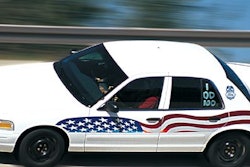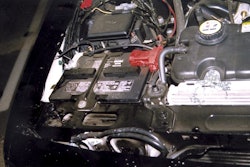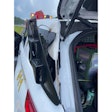If you want to know all the arguments for and against police pursuits, all you have to do is look at a recent case that culminated in a fatal accident on Georgia 54 just outside of Atlanta.
Last July, 37-year-old Loraine McCrary of Jonesboro was involved in a minor traffic mishap in the small central Georgia town of Luthersville. When the local police arrived and ran her license and registration, McCrary fired up her Ford Explorer with her kids inside and ran.
The subsequent 22-mile chase crossed three counties and ended in Peachtree City when McCrary's SUV slammed into a minivan driven by Chuck Vicha. Vicha, 44, was one of four innocent Atlanta-area motorists to die last year in accidents resulting from police chases. And his case is one of the reasons why Georgia agencies are modifying their pursuit policies.
At the time of the tragedy, the public and the press crucified Luthersville Police for endangering the public by chasing a woman at speeds of up to 120 mph just because of a minor traffic incident. However, it was later discovered that McCrary had a reason to rabbit. She was legally drunk, blowing .14; she had a history of passing bad paper, and Luthersville officers pulled 30 fraudulently obtained credit cards from her wrecked Explorer. McCrary, who was partially paralyzed in the accident, pleaded guilty to vehicular homicide and was sentenced to 15 years in prison.
Despite the successful prosecution of McCrary, the Luthersville chase was an unmitigated disaster for all involved. Vicha was killed, McCrary and her children were injured, and the tragedy will forever haunt the officers involved. It's little wonder that after such devastating accidents many police departments nationwide and in Canada, England, Australia, and New Zealand are deciding that many car chases just aren't worth the risks.
Grist for the Media Mill
As in the Luthersville case, when police pursuits go bad, the press swarms. So, spurred by the media, the public tends to blame the police every time a pursuit ends unsuccessfully.
Yes, and in a few cases, the police involved are guilty of recklessness and negligence and a just plain lack of common sense. But the real culprit is the rabbit. The motorist has the legal obligation to yield and stop when lawfully signaled by a police officer. The driver who fails to stop and elects to flee is the one responsible for placing his or her life in danger, placing the officers' lives in danger, and is a menace to the civilian population.
Ironically, the same media that pillories the police for chasing suspects has glamorized police pursuits.
Movies such as: "The French Connection," "Vanishing Point," "Bullitt," and, of course, both versions of "Gone in 60 Seconds" reinforce to the public how "cool" pursuits are. Unfortunately, the public doesn't realize that what they are watching in such films is a culmination of carefully orchestrated stunts, trick photography, and special effects.
Most people know that movies are make believe, but reality television shows such as "Cops," "Real Stories of the Highway Patrol," and others have made real-life pursuits attractive.
Even local TV news teams have gotten into the act pre-empting regular television programming whenever an exciting pursuit occurs with "live" coverage. An example of this occurred during O.J. Simpson's famous "low-speed pursuit." People like watching chases so much that there is even a subscription service that immediately notifies the subscriber by telephone or pager when the next live pursuit is broadcast on TV.
Such increased media attention has not done much to curtail pursuits. It's actually fanned the flames, as sick individuals seek their "15 minutes of fame" by trying to outrun the police. This is evidenced by the suspects who contemptuously flaunt the law by brandishing weapons, drinking alcohol, flashing gang symbols-as well as other hand gestures-and waving and smirking at the TV cameras while they drive.
Who Runs
Other than for fame and glory and to impress the "homies," there's another reason why people run from the police. They have nothing to lose and they believe that it's their only chance. Several states have enacted three-strike laws that "reward" repeat offenders with long-even life-prison terms when caught; thus they have another incentive to flee.
Also, as with most crimes involving motor vehicles, drug and alcohol abuse is certainly a factor in police pursuits. Anyone who has any appreciable amount of time in law enforcement knows how alcohol and drugs affect judgment and motor skills. Unfortunately, many pursuits involve impaired drivers running at high speed. Statistics also reflect that almost half of the fatal traffic collisions resulting from police chases involve alcohol and/or drug use.
Juvenile offenders are also big factors in car chases. They get a kick out of joy rides, and they love to hang it on the edge, mistakenly believing that they are immortal and invulnerable. Also, juveniles know that they won't have to do any serious time for any offense short of murder so they can thumb their noses at traffic laws. And finally, juveniles involved in police pursuits are likely to be juiced on alcohol or high on drugs.
Catching Big Fish
The Luthersville case is evidence of the dangers of car chases and the benefits. When someone runs from the police, they probably have a good reason beyond fear of a speeding ticket or whatever infraction originally attracted the attention of law enforcement officers. Any officer nationwide can tell you that terrorist bomber Timothy McVeigh was apprehended because of a minor traffic infraction.
McVeigh didn't run. But under today's climate of discouraging pursuits over traffic offenses, McVeigh could possibly have escaped if he'd decided to rabbit.
Telling criminals that they can get away if they run because law enforcement officers can't chase them won't be good for anybody. To arbitrarily ban all vehicle pursuits will quickly send a message that it is OK to run.[PAGEBREAK]
Pursuit Alternatives
Let's face it. Pursuits are dangerous, and when someone becomes injured or killed as a result of a police pursuit gone awry it becomes newsworthy. Letters to the editor fire up the politicians who get on the bandwagon to try to limit or eliminate pursuits. Those letters often detail citizens' ideas for alternatives to the hazards of police chases.
Some of these "solutions" are, well, laughable, such as: "Can't you just get the license number and go to the person's home later and arrest them?" Other "solutions" include putting the police in slower cars to prevent dangerous pursuits, or that old perennial of having the police "shoot the tires out" on a suspect's car before it can drive away. That last argument is proof that some otherwise intelligent people live in a comic book world when it comes to law enforcement.
Let's take a look at some of these solutions in terms of how practical they are and how effective they could be.
The suggestion of having an officer just obtain a license number and arrest the driver later may be a viable solution if the identity and residence of the driver are known. But there's a real big problem with this concept. Not everybody who runs from the police is driving his or her own personal vehicle. The vehicle may be stolen or borrowed. Or the license plates could have been removed, switched, or otherwise concealed.
That brings us to alternative number two, literally stripping the police of the ability to chase by equipping them with low-powered vehicles incapable of hot pursuit. There's historical precedent to show that this is ludicrous.
Fifty years ago, the Los Angeles Police Department made an exhaustive study of vehicle pursuits. At that time, the basic patrol car was powered by a six-cylinder engine, similar to what other major large cities-New York and Chicago-utilized as patrol cars. LAPD quickly learned that an officer driving an under-powered police car often got into trouble by out-driving the vehicle's capabilities. Surprisingly, when the police were given V-8 powered cars, the success rate in ending pursuits without injuries and property damage was considerably higher. Consequently, by the mid 1960s, the LAPD selected a mid-size Plymouth powered by 383-cubic-inch V-8, with a 4-barrel carburetor as its standard patrol vehicle.
The Royal Canadian Mounted Police fielded special service package Mustangs and Camaros in the late 1970s and early '80s when the performance of the available police sedan deteriorated due to mandated environmental concerns. RCMP brass predicted that the newly purchased high-performance pursuit vehicles would increase pursuits as the violators would see them as a challenge and actively attempt to outrun the police.
But the Mounties quickly learned a lesson that the LAPD learned a dozen years before: people are less inclined to try to outrun the combination of a formidable vehicle designed for pursuit driven by an officer who has been extensively trained in the art of pursuit driving. As one LAPD officer of the era said, "The best pursuit is no pursuit. The next best pursuit is a short pursuit."
Officer Discretion
While researching this article, POLICE magazine queried numerous law enforcement agencies nationwide. This survey covered large, medium, and small agencies, as well as specialized agencies, such as university police departments. Most agencies still leave the final decision to pursue with the officer and his or her immediate supervisor. Among all of the different policies, however, the "bottom line" at most agencies is don't chase unless: "the need to pursue outweighs the risks involved."
In reality, this almost must be on a case-by-case basis, and can be a double-edged sword. Many agencies frown on a pursuit based on a simple traffic violation. However, if the driver of the suspect vehicle takes off "and drives in a reckless manner," that changes things. Reckless driving is usually a misdemeanor, but it poses a danger to the public. Experience tells us that often when someone runs from the police they will continue to drive in a reckless manner long after eluding the officers. Will the public continue to be endangered after the officers have discontinued the pursuit? Perhaps so.
Other concerns must be considered beyond the seriousness of the offense. When deciding whether to pursue, officers should weigh the time of day, weather conditions, speeds involved, condition of the road, the immediate presence of vehicular and pedestrian traffic, the capabilities of their vehicles, quality of radio communications, their knowledge of the area, and their vehicle handling skills. Officers and supervisors should not be afraid to call off a pursuit if it exceeds their capabilities. When available, a helicopter is useful in taking over a pursuit.
Deadly Force
Many agencies are now using, or considering the application of, "legal intervention" such as ramming techniques, tire deflation devices, and even shooting at the suspect and/or vehicle. These tactics, however, may constitute deadly force and should be used appropriately.
In a recent pursuit of a Ford pickup suspected of transporting illegal immigrants, Border Patrol agents laid out a spike strip, which was successful in flattening the tires. However, the driver elected to continue fleeing at speeds up to 80 mph on the wheel rims. The driver lost control, and the truck overturned resulting in serious injuries and fatalities among the occupants.
Not only should police be aware that some of the measures they can take to end a car chase constitute deadly force, the public should be aware that running from the police constitutes a very real hazard to public safety. Using this logic, one of the best deterrents to police chases is stiff penalties for people who elect to foolishly flee from the police and endanger the public. Some states are addressing this issue, and they have made fleeing from the police a felony.
Agencies should in a car also take measures to prevent unnecessary pursuits, and prevent pursuits from getting out of control. In the old days, some officers would "invite" a pursuit by turning on the emergency lights a couple of blocks behind the violator and hoping that he (or she) would rabbit. Many officers felt that this was great "fun." Such a practice is no longer acceptable. Traffic conditions, liability issues, and the dangers to all involved are just too great.
John L. Bellah is a working police officer with more than 25 years of
experience in law enforcement. He is a frequent contributor to POLICE who
specializes in motor vehicle issues and patrol car evaluations.
















